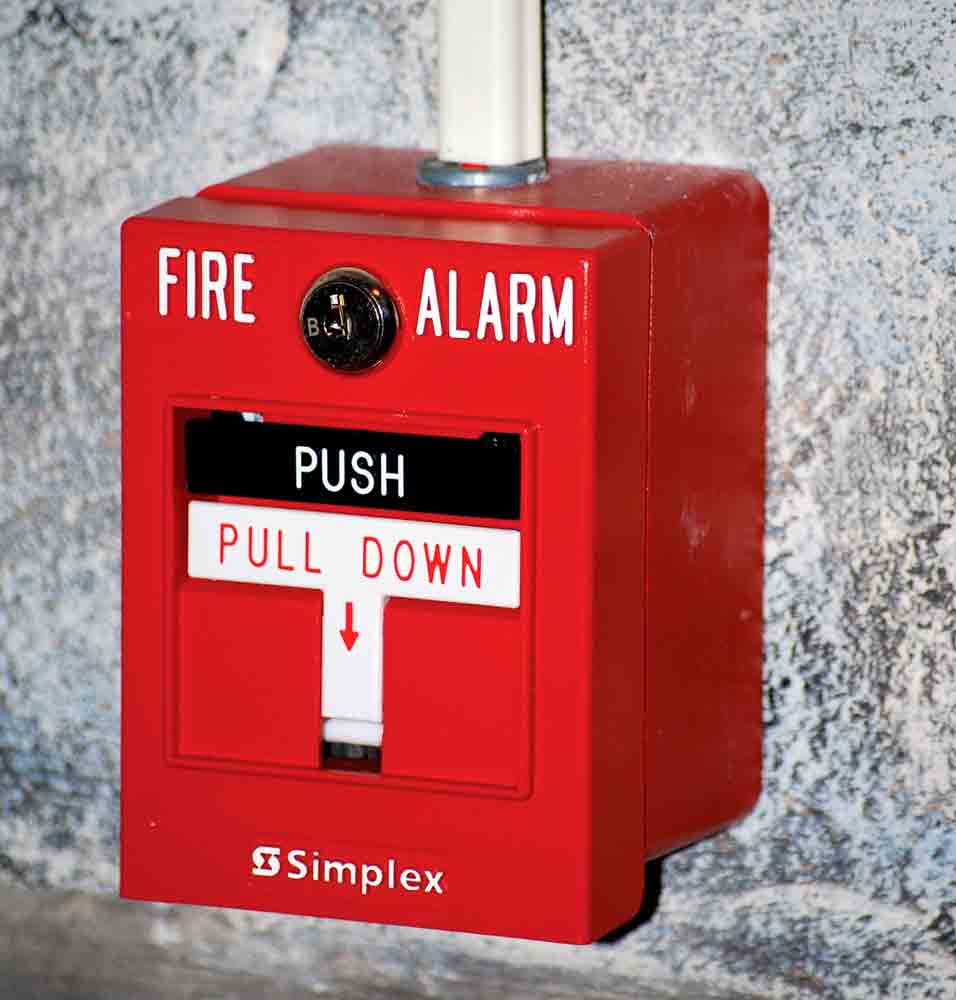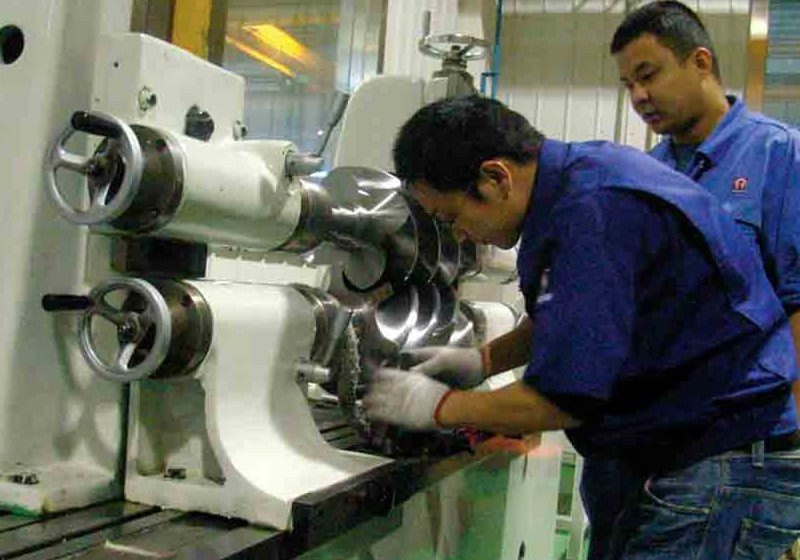Fire Alarm Systems and Elevator Interaction
Mar 1, 2012

A look at how fire alarm, sprinkler and elevator controls work together in accordance with present-day fire and electrical code mandates
Elevator technology has advanced over the years in the direction of greater performance and safety. Early versions were basically rope-and-basket affairs, with a loss of mechanical integrity likely resulting in user fatality. A great advance occurred in 1852, when Elisha Otis invented the safety elevator. If the lift cable broke or sheave failed, the car would not fall, due to a spring activated device that would engage the guide rails, which further developed into modern day safety. This development eliminated a whole class of potential disaster modes, but a major hazard persisted through the 1960s.
In the event of fire, one or more sprinkler heads will open, releasing an extraordinary amount of water. Generally, this will suffice to extinguish the fire before it can spread, provided there is adequate sprinkler-head distribution and sufficient water supply. It is possible, however, that due to the intensity of the fire and abundance of fuel supply, the release of water would not extinguish a fire. Moreover, if the sprinkler head were located adjacent to an elevator door, it would be possible for the release of water to short out the elevator call button, a normally open switch, bringing the elevator car to an affected floor. The automatic door, upon opening, would expose the car occupants to a fiery blast with tragic consequences.
These events would occur prior to the 1970s, when elevator functions became more integrated with buildings’ fire-alarm systems. Part of the operating protocol came to include elements that could prevent the above chain of events. We shall take a look at how fire alarm, sprinkler and elevator controls all work together in accordance with present-day fire and electrical code mandates. First, it is necessary to consider modern fire-alarm system requirements and how they are implemented on a design/build basis. Then, we’ll describe the elevator hookup(s).
It is important to note that the fire-alarm system that provides the protection we are contemplating consists of far more than a string of residential-type smoke detectors, even if they are wired together to operate in concert. While these may provide sufficient protection for a single-family dwelling or even multiple-occupancy apartment building, they fall far short of the protection required for a public building, especially if equipped with one or more elevators.
A fully functional fire-alarm system is characterized by the presence of a central control panel. An important feature of this type of system is that all elements are supervised on a continuous basis. Emphatically, this does not mean an individual sits at a monitor and watches for an alarm event. On the contrary, the monitoring is accomplished electronically, and human intervention is not required unless an abnormal state occurs.
The alarm system, as reported by the central control panel, will be in one of at least three states:
- Normal, in which there is no alarm event and all elements of the system are fully functional
- Alarm, in which one or more of the initiating devices detects an abnormal amount of smoke or heat: alarm devices will sound, and the control panel, at its alphanumeric user interface, will report the condition.
- Trouble, if the electronic monitoring capability detects a loss of functionality in the system but no direct evidence of fire.
There are two types of fire-alarm systems in use today – conventional and addressable. The addressable system was developed in the 1990s and is found in new and modernized installations. Conventional systems are common in older (“legacy”) installations, including small buildings where an upgrade has not seemed warranted. It is feasible to upgrade a conventional system to addressable status without replacing all the hardware. The existing control panel is retained with new circuit boards, and metal raceway throughout the building stays in place. As part of the upgrade, new wiring is pulled, addressable heads and bases are added, and the control panel is reprogrammed.
First, we’ll describe the structure and operation of a typical conventional fire-alarm system. There are numerous manufacturers. It is remarkable how similar their systems are, except for programming details. (The hardware, however, is not interchangeable.) The parts of a conventional system include central control panel, initiating device network and notification appliance network.
Commonly encountered initiating devices are smoke detectors, heat detectors and pull stations. Electrically, these are essentially the same, though they take different forms. They are wired in parallel strings called “zones” and may be in one of two states, non-alarm (off or non-conducting) and alarm (on or conducting). The pull station is a simple switch activated or placed in the alarm state by throwing a switch to turn it on. Frequently, the housing has a front glass panel that has to be broken before activation. (This helps deter vandals from creating a false alarm, because it has been found they will think twice before breaking the glass.)
The initiating devices are wired in one or more circuits, or zones. If all the initiating devices are in the off state, the system will not go into alarm. If any individual device becomes conductive, the system will go into alarm. Each zone is wired separately back to the control panel and connected to a pair of screw terminals on a terminal strip inside the enclosure, whereupon internal wiring connects each zone to a separate printed circuit board, or card. These cards are installed in slots and may be easily replaced if necessary. Each zone is wired through two conductors, which are fished through the metal raceway system so the initiating devices become daisy chained down a hallway or area of a building as needed to provide fire protection.
Most initiating-device conductors operate at 24 VDC so the system qualifies as power limited. One conductor is negative, and the other is positive. Both are isolated from ground. The metal raceway is grounded because of the connector at the control-panel chassis. The DC voltage on the conductors serves two purposes: it powers the solid-state smoke detectors and provides a supervisory voltage for the initiating-device circuits so they can be monitored by the control panel. At all times during the normal state, the zones are monitored for opens and shorts to ground (i.e., faults to the grounded raceway).
An open circuit can be differentiated from the normal, non-alarm state, where all initiating devices are at an essentially zero-ohm level because of an ingenious arrangement whereby an end-of-line resistor in the low kilohm range (varying with manufacturer) is placed after the initiating device farthest from the control panel. To remain in the normal state, the control panel must read this resistance at all times. The end-of-line resistor is placed in the base of the final initiating device. In Canada, this resistor is required to be in a separate enclosure. In Europe, an end-of-line capacitor is used. One fire-alarm manufacturer in New Zealand provides a control panel that can be programmed to accommodate either a resistor or capacitor.
The notification appliances may be horns, strobes or other signaling units. Chimes may be used in a nursing home or similar facility so the residents will not be disturbed. Strobes are used in conjunction with horns so hearing-impaired individuals can be notified. Notification appliances require larger conductors than initiating devices, since there is a fairly heavy current draw when all the horns are operated simultaneously. Typically, there are two voltages – a lower level to monitor the zone and a higher level to operate the appliances when the system goes into the alarm state.
The above comments apply to the conventional system. This system, it should be noted, provides monitoring of the internal control-panel circuitry. If a card goes bad, a trouble signal will be generated. Furthermore, since there is 24-VDC backup provided by 6- or 12-V batteries wired in series, a trouble signal will be generated if either AC or DC power is lost. The system will go down, and there will be no alarm capability only if both power supplies fail simultaneously – a highly unlikely occurrence.
The addressable fire-alarm system is a definite advance over the conventional system. It arrived on the scene in the mid 1980s and dominates the market today. In the conventional system, the fire-alarm control panel can only display the information it possesses, which, in the case of an alarm, is the zone in which the conducting initiating device is located. In an addressable system, each initiating device has a discrete digital address. The fire-alarm control panel interrogates each device every few seconds to ascertain its state plus other status information.
It is not necessary to inventory a separate replacement head for each location. The address is entered into each device base by inserting a programming card or by entering the binary address in some other way. Programming instructions for the bases and fire-alarm control panel are contained in the installation manual that comes with the equipment. These manuals are also available on the individual manufacturer’s websites.
The control panel is connected to two telephone lines, so the local fire department and/or an Underwriters Laboratories Inc.-listed central monitoring station will be notified in the event of a non-normal state. Test calls are automatically initiated by the control panel on a scheduled basis, and if either phone line goes down, a trouble signal will be generated so steps can be taken to correct the situation.
It is unthinkable that a fire should occur without activating the alarm system, without a trouble signal first being generated, and this is what is meant by the “supervisory” capability of the system. Additionally, the fire-alarm system is tied to the sprinkler system, so any water flow translates into a fire alarm. Thus, every sprinkler head becomes, in effect, an additional initiating device, vastly increasing the functionality of the fire-alarm system.
To design or install fire alarms, it is necessary to have a rather complete knowledge of sprinkler systems, since they are closely integrated into fire-alarm systems. A properly designed, installed and maintained sprinkler system with an abundant supply of water will knock down a fire before it can spread, and any water damage will be much less than the loss resulting from a spreadable fire. Sprinklers have been around for a long time. In the early 1800s, they consisted of nothing more than a series of nozzles arrayed across the ceilings of factories and industrial facilities. In the event of fire, workers would have to open a valve to release the water.
This arrangement was unsatisfactory due to the delay in initiating the water flow and possibility of freezing. Moreover, because of the impracticality of valving each head, there could be extensive water damage beyond the immediate area of the fire. Furthermore, water flow at the precise location of the fire would be less than optimal, and there would be no protection for the building when it was not attended. These defects were eliminated in 1890 by the invention of the glass disc automatic sprinkler head, still in use today. A glass bulb that would shatter or a metal alloy that would melt at a predetermined temperature ensured water would be released only where needed. If the fire managed to spread, additional heads would activate, and most fires will be quickly extinguished. After humans have verified the fire is out, the water valve for the affected zone can be shut off and water drained until new heads are installed.
To be effective, sprinklers need to have an abundant water supply. Those not familiar with the inner workings of these systems assume they are simply connected to the domestic water supply. This is not the case. An oversize lateral pipe with no constrictions has to be run from the water main, or a separate (not necessarily potable) water supply must be connected, via a large pipe, to a reservoir, elevated tank or other supply.
There are two types of sprinkler zones, wet and dry, which may coexist within the same building. In a wet system, the piping supplying the sprinkler heads is directly connected to the water supply. It is filled with water and fully pressurized at all times, except when intentionally drained. In a dry system, the zone piping is filled with air pressurized to a certain preset level. If the pressure drops (by design, due to the opening of one or more sprinkler heads), an automatic valve will open. Air escaping through the open head(s) will permit water flow.
In some ways, the wet system is preferable. Water delivery is instantaneous, whereas in the dry system, it can take up to a minute. The wet system is actually less vulnerable to corrosion, because in the dry system, there will be a mixture of damp air and water from condensation, which is worse than fully pressurized water (where there is less oxygen) from the standpoint of corrosion. The big advantage of the dry system is it is less vulnerable to freezing, though low spots and condensation in the branch pipe run can be problematic.
Typically, in the dry system, the water supply will be at 160 psi ahead of the automatic valve. Though this pressure is higher than the zone air pressure, the automatic valve will not open unless the air pressure drops to a certain level. This is due to a spring-loaded flipper. An air compressor is connected to the dry portion of the piping, after the zone valve. It may be regulated to maintain a predetermined air pressure, or each zone may have an air valve and gauge so air can be added manually.
Operating pressure in the dry side should be set for about 55 psi. If it drops to 50 psi, air may be added. If it drops to 39 psi, a trouble notification will appear at the fire-alarm control panel, with the alphanumeric display indicating which zone is low. If the air pressure drops to 31 psi (these are typical values), the flipper will trip, and the zone will flood. Still, there will be no release of water, since the sprinkler heads remain closed. However, water will be released if there is a broken pipe that caused air loss in the first place. Additionally, the fire-alarm system will enter the alarm state, and its horns will sound. An automatic call will alert the fire department or central monitoring station, fire doors will close, any flammable gas supply will be shut off, and other actions programmed into the fire-alarm control panel will take place.
A newer dry system will rely upon the trouble notification at the fire-alarm control panel to alert maintenance personnel to add air, and find and correct the leak. For an older system that may have thousands of feet of threaded steel piping, it may be necessary to have someone check each zone’s air-pressure gauge every few hours and add air as necessary. A log is usually kept so trends can be noted and corrective action taken. Sometimes, a slow leak is difficult to pinpoint, and it is necessary to intentionally flood the system, first disabling the affected zone at the fire-alarm control panel. Disabling a zone initiates a trouble signal, so the central monitoring station should be informed in advance.
Years ago, water flow within a sprinkler system would pass through a water-powered gong, producing a loud alarm. Now this is accomplished electrically, by means of a water-flow sensor wired back to the fire-alarm control panel. Additionally, a tamper switch will produce a trouble signal if the zone water valve is closed. Also, there is the low-air trouble alert mentioned earlier.
These are the principle characteristics of the widely used sprinkler system. Although not required in all occupancies, sprinkler systems add capability to fire-alarm systems and may save life and property. Several building systems, as we have seen, beneficially interact with the fire-alarm system. A prominent one of these is the system of one or more elevators found in every building that rises above a very few stories.
We have mentioned the problem of an elevator car with passengers being called to precisely the floor that is the scene of a hot fire. The fire-alarm system prevents this from happening. Another protective action, shunt trip, disconnects the main elevator power supply in the machine room prior to sprinkler activation, if these areas are so equipped. A heat-sensing initiating device is placed next to the sprinkler head. This device has a lower temperature threshold than the sprinkler head, so that power to the elevator will be shut off prior to the flow of water. This action is of great importance, because the flow of water will prevent elevator machine brake mechanisms from working and short out electrical-control wiring, disrupting the many safety features we depend upon.
Two other emergency actions kick in when fire threatens the normal operation of the elevators. Phase I Emergency Recall returns elevator cars nonstop to a safe location in the event of fire. This is usually the ground floor. However, if the alarm condition originates from an initiating device at that location, an alternate floor, chosen in advance, will be the destination. Phase II Firefighters’ Operation becomes operative later, after responders have arrived. It is only available upon insertion of a special key into a Phase II operation key switch. Phase II overrides Phase I so firefighters can manually control the elevator, including opening and closing the doors. It is important that firefighters have access to and control of the elevators during the course of their work. They need to use them to access certain floors that may be crucial in neutralizing the inferno. Also, they have special training, so they know what not to do (i.e., go to a floor that is heavily involved and open the elevator door, exposing themselves to a blast of fire).
We have looked at the fire-alarm system and how it interacts with other building systems. Many elevator technicians understand how to do the hookups that are part of their work, but when the system is first seen to act erratically, a more detailed understanding may be necessary to get things back on track and ensure reliable operation in years to come.
Get more of Elevator World. Sign up for our free e-newsletter.





